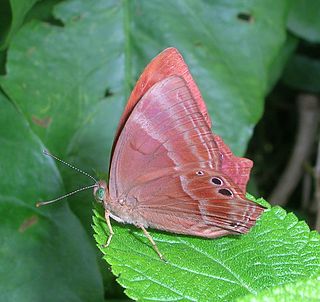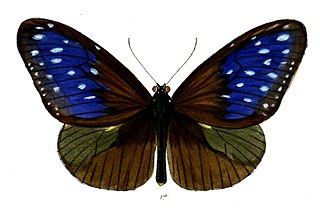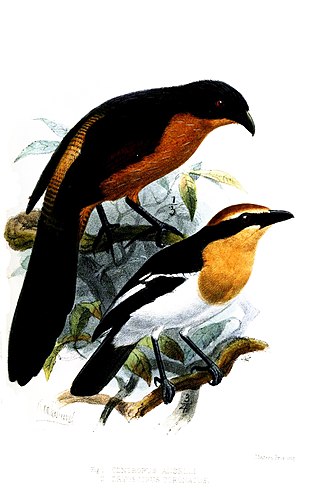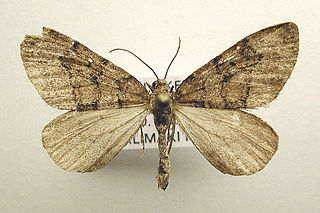
The Cape crow or black crow is slightly larger than the carrion crow and is completely black with a slight gloss of purple in its feathers. It has proportionately longer legs, wings and tail too and has a much longer, slimmer bill that seems to be adapted for probing into the ground for invertebrates. The head feathers have a coppery-purple gloss and the throat feathers are quite long and fluffed out in some calls and displays.

The brown-necked raven is a larger bird than the carrion crow though not as large as the common raven. It has similar proportions to the common raven but the bill is not so large or deep and the wings tend to be a little more pointed in profile. The head and throat are a distinct brownish-black giving the bird its English name, while the rest of the plumage is black glossed with purple, blue or purplish-blue. Like the common raven, thick-billed raven and white-necked raven, it is one of the larger raven species. The feathers of this species often fade quite quickly to a brownish black and the bird can look distinctly brown by the time it moults. The feet, legs and bill are black. The dwarf raven was formerly considered a subspecies but this bird now appears to be closer to the pied crow than this species.

The purple hairstreak is a butterfly in the family Lycaenidae distributed throughout much of Europe, North Africa, Anatolia, Caucasia, and Transcaucasia. The larva feeds on Quercus robur, Quercus petraea, Quercus cerris and Quercus ilex.

Abisara echerius, the plum Judy, is a small but striking butterfly found in Asia belonging to the Punches and Judies family (Riodinidae). It is difficult to distinguish it from Abisara bifasciata.

Euploea mulciber, the striped blue crow, is a butterfly found in India and Southeast Asia that belongs to the crows and tigers, that is, the danaid group of the brush-footed butterflies family.

Stephanie's astrapia, also known as Princess Stephanie's astrapia, is a species of bird-of-paradise of the family Paradisaeidae, native to the Bird's Tail Peninsula. This species was first described by Carl Hunstein in 1884.

The purple-edged copper is a butterfly of the family Lycaenidae.

Amblypodia anita, the purple leaf blue or leaf blue, is a lycaenid or blue butterfly found in South Asia and Southeast Asia, including Sri Lanka, India, Myanmar, Malaysia, and Java. The species was first described by William Chapman Hewitson in 1862.

Gangara lebadea, commonly known as the banded redeye, is a species of hesperid butterfly found in Southeast Asia.

The Gabon coucal is a species of cuckoo in the family Cuculidae. It is mainly found in Gabon but also occurs in neighboring areas of Cameroon, Angola, the Central African Republic, the western Congo Basin and Equatorial Guinea.

The yellow-faced myna is a species of starling in the family Sturnidae. It is found in New Guinea and nearby smaller islands, where its natural habitat is subtropical or tropical moist lowland forests. The long-tailed myna was formerly included as a subspecies. One of the largest species of starling, this species attains 23 to 26 cm in length and weighs around 217 g (7.7 oz). They have dark plumage with a metallic lustre and bright orange facial markings and beak. These birds are social and omnivorous. Their diet consists of fruit and insects for which they forage high in the canopy. They are common birds with a wide range, and the International Union for Conservation of Nature has assessed their conservation status as being of "least concern".

Thera cognata, the chestnut-coloured carpet or Durham juniper moth, is a moth of the family Geometridae. The species was first described by Carl Peter Thunberg in 1792. It is found in Europe, Asia Minor, the Caucasus and Transcaucasus.
Amblyodipsas concolor, also known as the KwaZulu-Natal purple-glossed snake or Natal purple-glossed snake, is a species of venomous rear-fanged snake in the Atractaspididae family.
Clupeosoma atristriata is a moth in the family Crambidae. It was described by George Hampson in 1917. It is found in Papua New Guinea, including the Bismarck Archipelago and Indonesia, where it has been recorded from Timur.
Diaphania euryzonalis is a moth in the family Crambidae. It was described by George Hampson in 1912. It is found in Colombia, Ecuador, Venezuela, Peru, Bolivia, Brazil, Costa Rica and Mexico. The habitat consists of cloud forests.
Diaphania columbiana is a moth in the family Crambidae. It was described by George Hampson in 1899. It is found in Guatemala, Colombia, Ecuador, Peru, Bolivia and Paraguay.
Diaphania nigricilialis is a moth in the family Crambidae. It was described by William Schaus in 1912. It is found in Costa Rica, Colombia and Venezuela.
Diaphania arguta is a moth in the family Crambidae. It was described by Julius Lederer in 1863. It is found in Florida, Mexico, Guatemala, Costa Rica, Panama, Colombia, Venezuela, Trinidad, Tobago, Guyana, French Guiana, Suriname, Brazil, Peru and Bolivia.
Diaphania elegans is a moth in the family Crambidae. It was described by Heinrich Benno Möschler in 1890. It is found in Puerto Rico, Hispaniola, Jamaica, Cuba, Costa Rica, Panama, Guatemala, Honduras, Mexico and southern Texas. It is also found in South America, where it has been recorded from Venezuela, Trinidad, Ecuador, Peru, Brazil, Paraguay and Argentina.
Diaphania lucidalis is a moth in the family Crambidae. It was described by Jacob Hübner in 1823. It is found in Panama, Grenada, Cuba, Jamaica, Venezuela, Ecuador, Brazil, Bolivia and Paraguay.












